HLTENN003 & HLTENN004: Clinical Assessment, Planning, and Nursing Care
VerifiedAdded on 2020/06/03
|10
|3098
|557
Homework Assignment
AI Summary
This document provides a comprehensive overview of the key concepts related to HLTENN003 and HLTENN004, focusing on clinical assessment and nursing care planning. It covers various aspects, including the application of the nursing core standards, nutritional assessment, and the impact of factors such as genetics and environment on human development. The assignment delves into the developmental stages across the lifespan, from infancy through adulthood, highlighting physical, psychosocial, cognitive, and motor development. It explores common health issues in adolescents, family healthcare needs, and gender-specific healthcare considerations. Furthermore, it discusses psychological theories like Erikson's stages of development, and different healthcare approaches. The assignment also examines the impact of infertility on individuals and relationships, along with factors affecting comfort, rest, and sleep. It concludes by emphasizing the role of grooming and hygiene in disease prevention and promoting self-esteem. This assignment is designed to equip enrolled nurses with the knowledge and skills necessary to perform clinical assessments and contribute to effective nursing care planning.

HLTENN003 &
HLTENN004
HLTENN004
Paraphrase This Document
Need a fresh take? Get an instant paraphrase of this document with our AI Paraphraser
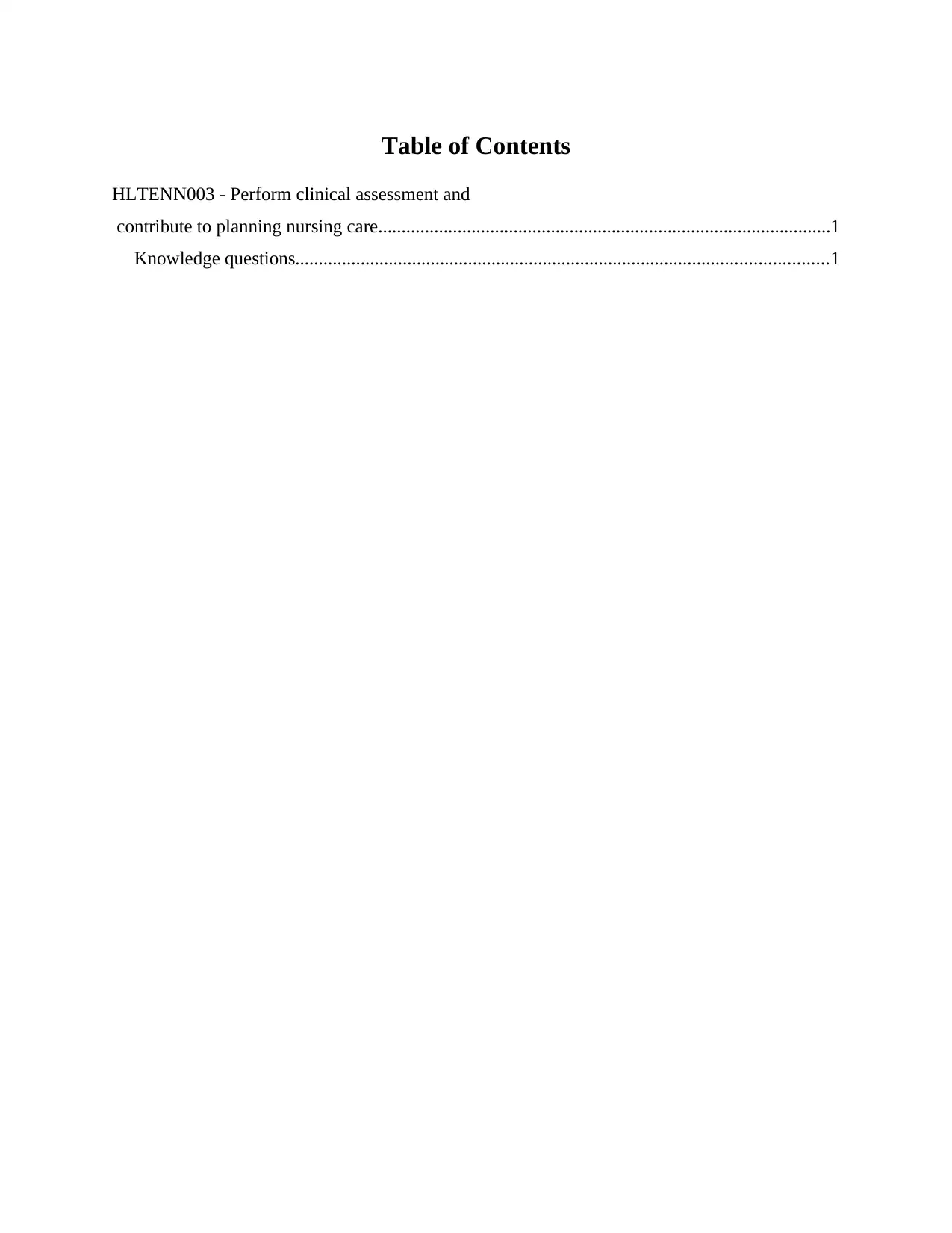
Table of Contents
HLTENN003 - Perform clinical assessment and
contribute to planning nursing care.................................................................................................1
Knowledge questions..................................................................................................................1
HLTENN003 - Perform clinical assessment and
contribute to planning nursing care.................................................................................................1
Knowledge questions..................................................................................................................1
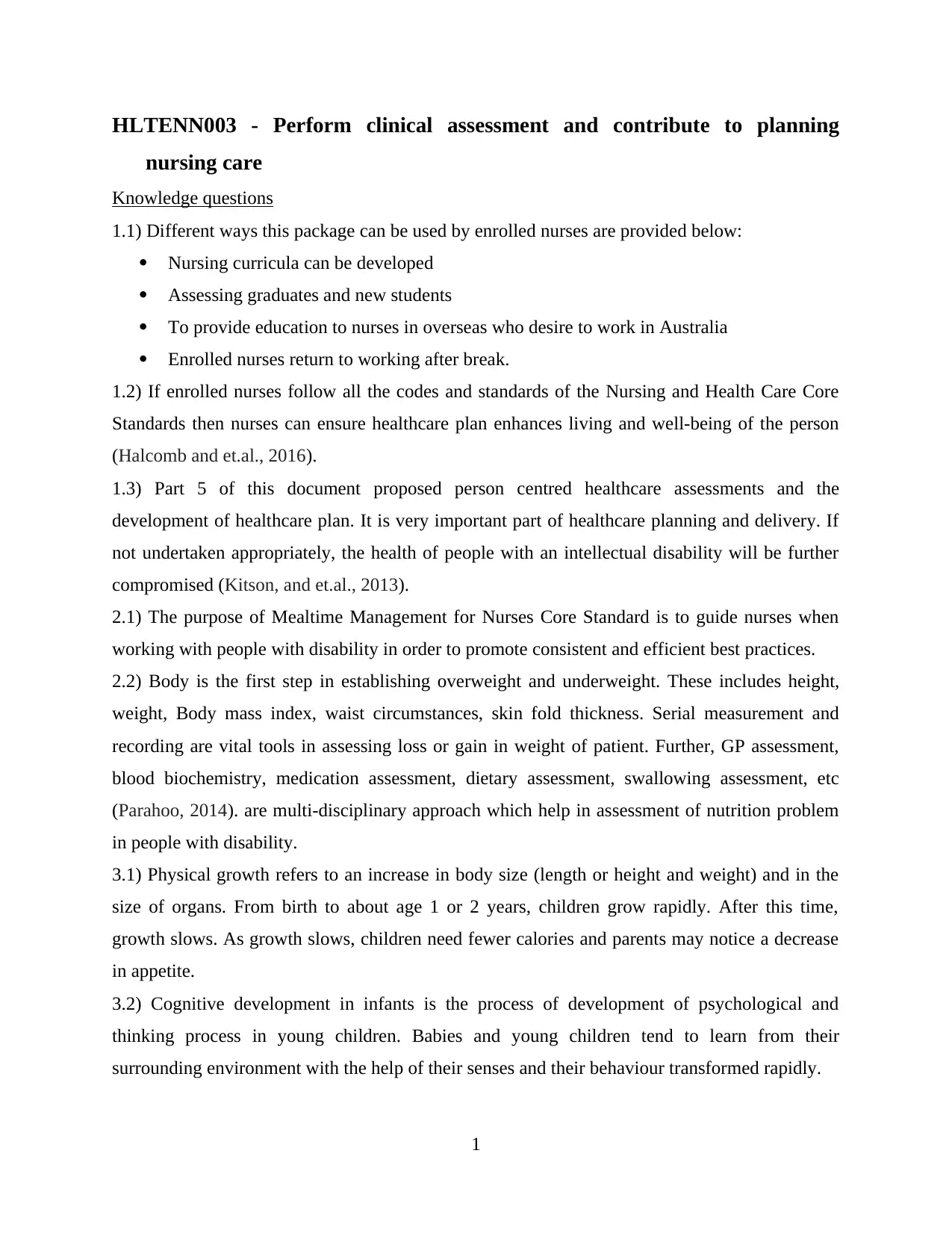
HLTENN003 - Perform clinical assessment and contribute to planning
nursing care
Knowledge questions
1.1) Different ways this package can be used by enrolled nurses are provided below:
Nursing curricula can be developed
Assessing graduates and new students
To provide education to nurses in overseas who desire to work in Australia
Enrolled nurses return to working after break.
1.2) If enrolled nurses follow all the codes and standards of the Nursing and Health Care Core
Standards then nurses can ensure healthcare plan enhances living and well-being of the person
(Halcomb and et.al., 2016).
1.3) Part 5 of this document proposed person centred healthcare assessments and the
development of healthcare plan. It is very important part of healthcare planning and delivery. If
not undertaken appropriately, the health of people with an intellectual disability will be further
compromised (Kitson, and et.al., 2013).
2.1) The purpose of Mealtime Management for Nurses Core Standard is to guide nurses when
working with people with disability in order to promote consistent and efficient best practices.
2.2) Body is the first step in establishing overweight and underweight. These includes height,
weight, Body mass index, waist circumstances, skin fold thickness. Serial measurement and
recording are vital tools in assessing loss or gain in weight of patient. Further, GP assessment,
blood biochemistry, medication assessment, dietary assessment, swallowing assessment, etc
(Parahoo, 2014). are multi-disciplinary approach which help in assessment of nutrition problem
in people with disability.
3.1) Physical growth refers to an increase in body size (length or height and weight) and in the
size of organs. From birth to about age 1 or 2 years, children grow rapidly. After this time,
growth slows. As growth slows, children need fewer calories and parents may notice a decrease
in appetite.
3.2) Cognitive development in infants is the process of development of psychological and
thinking process in young children. Babies and young children tend to learn from their
surrounding environment with the help of their senses and their behaviour transformed rapidly.
1
nursing care
Knowledge questions
1.1) Different ways this package can be used by enrolled nurses are provided below:
Nursing curricula can be developed
Assessing graduates and new students
To provide education to nurses in overseas who desire to work in Australia
Enrolled nurses return to working after break.
1.2) If enrolled nurses follow all the codes and standards of the Nursing and Health Care Core
Standards then nurses can ensure healthcare plan enhances living and well-being of the person
(Halcomb and et.al., 2016).
1.3) Part 5 of this document proposed person centred healthcare assessments and the
development of healthcare plan. It is very important part of healthcare planning and delivery. If
not undertaken appropriately, the health of people with an intellectual disability will be further
compromised (Kitson, and et.al., 2013).
2.1) The purpose of Mealtime Management for Nurses Core Standard is to guide nurses when
working with people with disability in order to promote consistent and efficient best practices.
2.2) Body is the first step in establishing overweight and underweight. These includes height,
weight, Body mass index, waist circumstances, skin fold thickness. Serial measurement and
recording are vital tools in assessing loss or gain in weight of patient. Further, GP assessment,
blood biochemistry, medication assessment, dietary assessment, swallowing assessment, etc
(Parahoo, 2014). are multi-disciplinary approach which help in assessment of nutrition problem
in people with disability.
3.1) Physical growth refers to an increase in body size (length or height and weight) and in the
size of organs. From birth to about age 1 or 2 years, children grow rapidly. After this time,
growth slows. As growth slows, children need fewer calories and parents may notice a decrease
in appetite.
3.2) Cognitive development in infants is the process of development of psychological and
thinking process in young children. Babies and young children tend to learn from their
surrounding environment with the help of their senses and their behaviour transformed rapidly.
1
⊘ This is a preview!⊘
Do you want full access?
Subscribe today to unlock all pages.

Trusted by 1+ million students worldwide
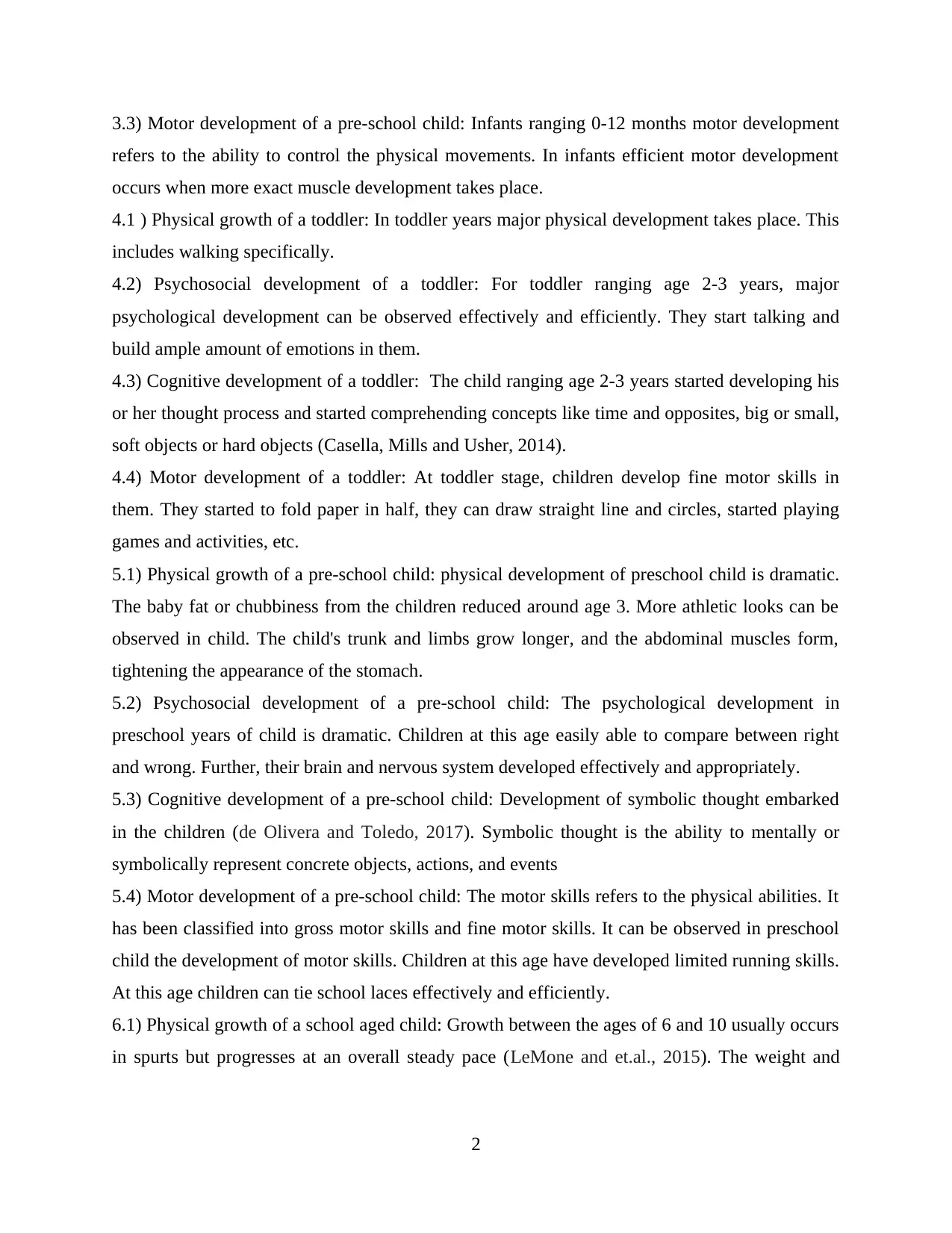
3.3) Motor development of a pre-school child: Infants ranging 0-12 months motor development
refers to the ability to control the physical movements. In infants efficient motor development
occurs when more exact muscle development takes place.
4.1 ) Physical growth of a toddler: In toddler years major physical development takes place. This
includes walking specifically.
4.2) Psychosocial development of a toddler: For toddler ranging age 2-3 years, major
psychological development can be observed effectively and efficiently. They start talking and
build ample amount of emotions in them.
4.3) Cognitive development of a toddler: The child ranging age 2-3 years started developing his
or her thought process and started comprehending concepts like time and opposites, big or small,
soft objects or hard objects (Casella, Mills and Usher, 2014).
4.4) Motor development of a toddler: At toddler stage, children develop fine motor skills in
them. They started to fold paper in half, they can draw straight line and circles, started playing
games and activities, etc.
5.1) Physical growth of a pre-school child: physical development of preschool child is dramatic.
The baby fat or chubbiness from the children reduced around age 3. More athletic looks can be
observed in child. The child's trunk and limbs grow longer, and the abdominal muscles form,
tightening the appearance of the stomach.
5.2) Psychosocial development of a pre-school child: The psychological development in
preschool years of child is dramatic. Children at this age easily able to compare between right
and wrong. Further, their brain and nervous system developed effectively and appropriately.
5.3) Cognitive development of a pre-school child: Development of symbolic thought embarked
in the children (de Olivera and Toledo, 2017). Symbolic thought is the ability to mentally or
symbolically represent concrete objects, actions, and events
5.4) Motor development of a pre-school child: The motor skills refers to the physical abilities. It
has been classified into gross motor skills and fine motor skills. It can be observed in preschool
child the development of motor skills. Children at this age have developed limited running skills.
At this age children can tie school laces effectively and efficiently.
6.1) Physical growth of a school aged child: Growth between the ages of 6 and 10 usually occurs
in spurts but progresses at an overall steady pace (LeMone and et.al., 2015). The weight and
2
refers to the ability to control the physical movements. In infants efficient motor development
occurs when more exact muscle development takes place.
4.1 ) Physical growth of a toddler: In toddler years major physical development takes place. This
includes walking specifically.
4.2) Psychosocial development of a toddler: For toddler ranging age 2-3 years, major
psychological development can be observed effectively and efficiently. They start talking and
build ample amount of emotions in them.
4.3) Cognitive development of a toddler: The child ranging age 2-3 years started developing his
or her thought process and started comprehending concepts like time and opposites, big or small,
soft objects or hard objects (Casella, Mills and Usher, 2014).
4.4) Motor development of a toddler: At toddler stage, children develop fine motor skills in
them. They started to fold paper in half, they can draw straight line and circles, started playing
games and activities, etc.
5.1) Physical growth of a pre-school child: physical development of preschool child is dramatic.
The baby fat or chubbiness from the children reduced around age 3. More athletic looks can be
observed in child. The child's trunk and limbs grow longer, and the abdominal muscles form,
tightening the appearance of the stomach.
5.2) Psychosocial development of a pre-school child: The psychological development in
preschool years of child is dramatic. Children at this age easily able to compare between right
and wrong. Further, their brain and nervous system developed effectively and appropriately.
5.3) Cognitive development of a pre-school child: Development of symbolic thought embarked
in the children (de Olivera and Toledo, 2017). Symbolic thought is the ability to mentally or
symbolically represent concrete objects, actions, and events
5.4) Motor development of a pre-school child: The motor skills refers to the physical abilities. It
has been classified into gross motor skills and fine motor skills. It can be observed in preschool
child the development of motor skills. Children at this age have developed limited running skills.
At this age children can tie school laces effectively and efficiently.
6.1) Physical growth of a school aged child: Growth between the ages of 6 and 10 usually occurs
in spurts but progresses at an overall steady pace (LeMone and et.al., 2015). The weight and
2
Paraphrase This Document
Need a fresh take? Get an instant paraphrase of this document with our AI Paraphraser

height of children started to transform and children lose their baby teeth and grow permanent
teeth at this age.
6.2) Psychosocial development of a school aged child: Emotional development takes place and
children tend to feel independent (Lea and Cruickshank, 2015). Child at this stage begin to think
more efficiently and able to socialise in the environment effectively and efficiently.
6.3) Cognitive development of a school aged child: Cognitive development at this stage is
dramatic and interesting. The child become more responsible and understand about the money.
He or she can tell time and enjoy reading book on their own.
6.4) Motor development of a school aged child: The fine motor development becomes more
efficient as the child body starts to move and become more stable. Gross motor skills like
jumping, climbing, sports, etc. tends to develop adequately in child at school years.
7.1) Influences of genetics on human development: Genetics greatly influences on human growth
and development. Child acquired genes of both his or her mother and father. This impacts on the
growth and development plus behaviour of the child. The two most important chemicals which
are involved in genetic transmission are “DNA” or deoxyribonucleic acid and “RNA” or
ribonucleic acid (Thompson and et.al., 2015). These two complex chemical acids work together.
Thus, it impacts and influences the human growth and development.
7.2) Influences of environment on human development: The influence of environment on the
human growth and development is referred to as nurture. The earlier view of child development
focused either entirely on nature or nurture. It includes society an individual lives in. The
observation and behaviour in the surrounding environment influences the growth and
development of human being.
7.3) Role of play in a child’s development: Role play is very essential for child growth and
development. It assists the child to develop confidence, develop physical abilities, creative
communication and problem-solving skills development. Thus, it improves the overall
psychological process of children and helps him to move towards growth and development.
7.4) Impact of hospitalisation on child and family: Frequent hospitalisation impacts negatively
on child and family (Caldwell, Low and Brodaty, 2014). Emotional upset can be observed and
tension and anxiety between family increases rapidly.
8) Stages of adulthood according to Daniel Levinson Theory
3
teeth at this age.
6.2) Psychosocial development of a school aged child: Emotional development takes place and
children tend to feel independent (Lea and Cruickshank, 2015). Child at this stage begin to think
more efficiently and able to socialise in the environment effectively and efficiently.
6.3) Cognitive development of a school aged child: Cognitive development at this stage is
dramatic and interesting. The child become more responsible and understand about the money.
He or she can tell time and enjoy reading book on their own.
6.4) Motor development of a school aged child: The fine motor development becomes more
efficient as the child body starts to move and become more stable. Gross motor skills like
jumping, climbing, sports, etc. tends to develop adequately in child at school years.
7.1) Influences of genetics on human development: Genetics greatly influences on human growth
and development. Child acquired genes of both his or her mother and father. This impacts on the
growth and development plus behaviour of the child. The two most important chemicals which
are involved in genetic transmission are “DNA” or deoxyribonucleic acid and “RNA” or
ribonucleic acid (Thompson and et.al., 2015). These two complex chemical acids work together.
Thus, it impacts and influences the human growth and development.
7.2) Influences of environment on human development: The influence of environment on the
human growth and development is referred to as nurture. The earlier view of child development
focused either entirely on nature or nurture. It includes society an individual lives in. The
observation and behaviour in the surrounding environment influences the growth and
development of human being.
7.3) Role of play in a child’s development: Role play is very essential for child growth and
development. It assists the child to develop confidence, develop physical abilities, creative
communication and problem-solving skills development. Thus, it improves the overall
psychological process of children and helps him to move towards growth and development.
7.4) Impact of hospitalisation on child and family: Frequent hospitalisation impacts negatively
on child and family (Caldwell, Low and Brodaty, 2014). Emotional upset can be observed and
tension and anxiety between family increases rapidly.
8) Stages of adulthood according to Daniel Levinson Theory
3

Early Adult Transition: It begins at age from 16 to 24. The three major changes are
emotional, psychological and physiological changes that occurred in early adulthood
stages.
Forming A life structure (24-28): In this stage adults are more precise about their life and
formulate a structure that will aid in their growth and development.
Settling down (29-34): In this stage, an adult settle down in societies and focus on both
family and career.
Becoming One's own man (35-40): In this stage of adulthood, adult focus on his dreams
and aspirations and aim to accomplish them.
Midlife Transition (40-45): Adults are seen more as parents at this stage (DiCenso,
Guyatt and Ciliska, 2014).
Restablisation and late adulthood (45 – above): In this stage, adult spent more of their
time in reflecting about past achievements and accomplishments.
9) The developmental stages of adolescence are:
Physical development: At adolescence, puberty is defined as the biological changes. The
youngster sooner develop height and weight of young adult at physical development of
adolescence stage.
Intellectual development: Intellectual development and growth rises rapidly. Girls and
boys tends to appreciate the concerns of other and dilemma situations increases among
them.
Emotional development: Strong emotional development can be observed in the youngster
and conflicts between them and parents can be observed (Lubbe and Roets, 2014).
Social Development: Youngsters and adolescences socialise with friends and sociteies.
Social development increases rapidly in this stage.
10.1) Common health issues for adolescents: The common health issue that can be observed in
adolescence are mental and psychological disorder, early childbirth or pregnancy, HIV, violence,
alcohol and drugs, malnutrition and obesity and acne problems.
10.2)Family health care needs in general: Family plays an important role in healthcare of
children. They guide and motivate children on the right direction which increases their
motivation and reduces health issues like anxiety and stress level.
4
emotional, psychological and physiological changes that occurred in early adulthood
stages.
Forming A life structure (24-28): In this stage adults are more precise about their life and
formulate a structure that will aid in their growth and development.
Settling down (29-34): In this stage, an adult settle down in societies and focus on both
family and career.
Becoming One's own man (35-40): In this stage of adulthood, adult focus on his dreams
and aspirations and aim to accomplish them.
Midlife Transition (40-45): Adults are seen more as parents at this stage (DiCenso,
Guyatt and Ciliska, 2014).
Restablisation and late adulthood (45 – above): In this stage, adult spent more of their
time in reflecting about past achievements and accomplishments.
9) The developmental stages of adolescence are:
Physical development: At adolescence, puberty is defined as the biological changes. The
youngster sooner develop height and weight of young adult at physical development of
adolescence stage.
Intellectual development: Intellectual development and growth rises rapidly. Girls and
boys tends to appreciate the concerns of other and dilemma situations increases among
them.
Emotional development: Strong emotional development can be observed in the youngster
and conflicts between them and parents can be observed (Lubbe and Roets, 2014).
Social Development: Youngsters and adolescences socialise with friends and sociteies.
Social development increases rapidly in this stage.
10.1) Common health issues for adolescents: The common health issue that can be observed in
adolescence are mental and psychological disorder, early childbirth or pregnancy, HIV, violence,
alcohol and drugs, malnutrition and obesity and acne problems.
10.2)Family health care needs in general: Family plays an important role in healthcare of
children. They guide and motivate children on the right direction which increases their
motivation and reduces health issues like anxiety and stress level.
4
⊘ This is a preview!⊘
Do you want full access?
Subscribe today to unlock all pages.

Trusted by 1+ million students worldwide
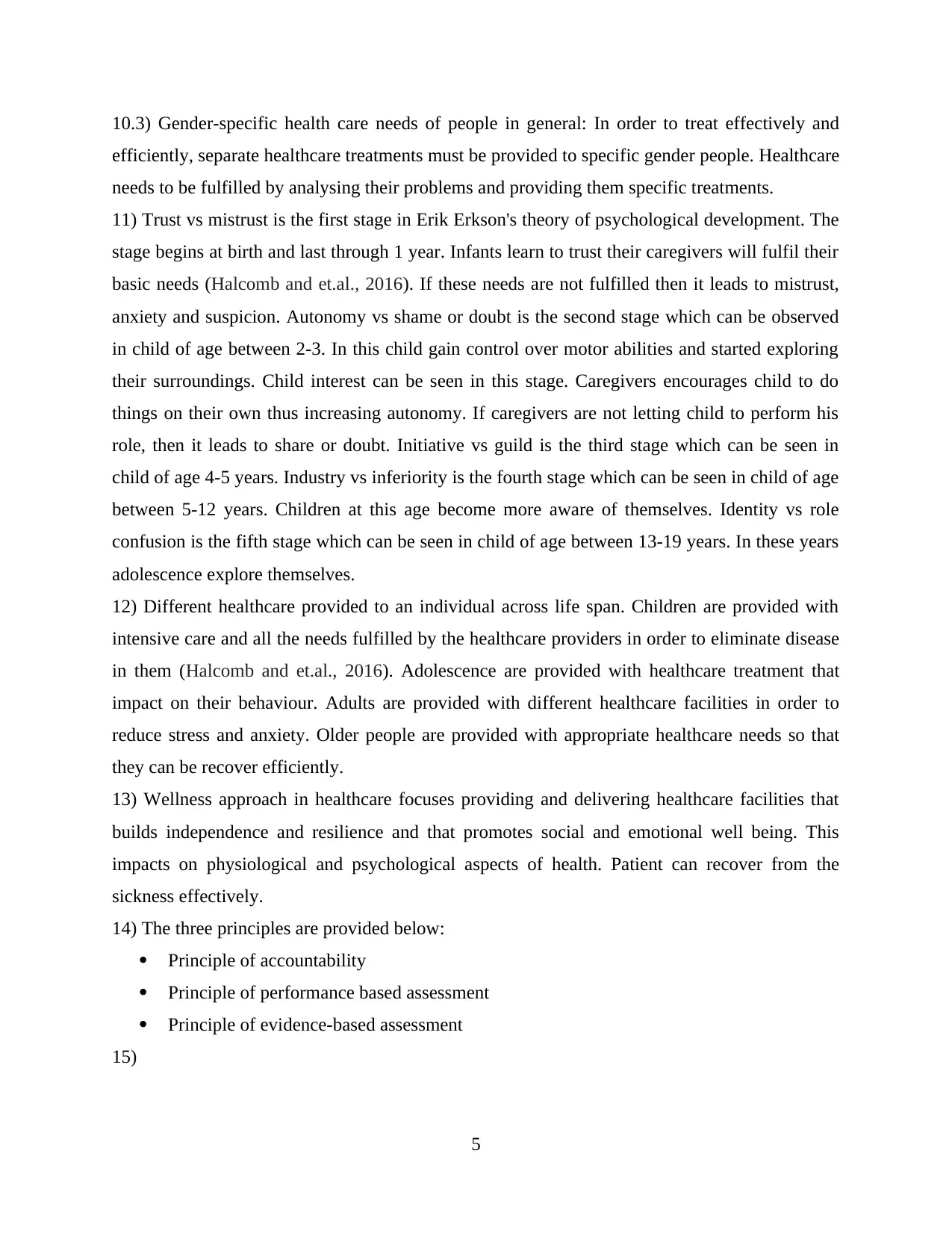
10.3) Gender-specific health care needs of people in general: In order to treat effectively and
efficiently, separate healthcare treatments must be provided to specific gender people. Healthcare
needs to be fulfilled by analysing their problems and providing them specific treatments.
11) Trust vs mistrust is the first stage in Erik Erkson's theory of psychological development. The
stage begins at birth and last through 1 year. Infants learn to trust their caregivers will fulfil their
basic needs (Halcomb and et.al., 2016). If these needs are not fulfilled then it leads to mistrust,
anxiety and suspicion. Autonomy vs shame or doubt is the second stage which can be observed
in child of age between 2-3. In this child gain control over motor abilities and started exploring
their surroundings. Child interest can be seen in this stage. Caregivers encourages child to do
things on their own thus increasing autonomy. If caregivers are not letting child to perform his
role, then it leads to share or doubt. Initiative vs guild is the third stage which can be seen in
child of age 4-5 years. Industry vs inferiority is the fourth stage which can be seen in child of age
between 5-12 years. Children at this age become more aware of themselves. Identity vs role
confusion is the fifth stage which can be seen in child of age between 13-19 years. In these years
adolescence explore themselves.
12) Different healthcare provided to an individual across life span. Children are provided with
intensive care and all the needs fulfilled by the healthcare providers in order to eliminate disease
in them (Halcomb and et.al., 2016). Adolescence are provided with healthcare treatment that
impact on their behaviour. Adults are provided with different healthcare facilities in order to
reduce stress and anxiety. Older people are provided with appropriate healthcare needs so that
they can be recover efficiently.
13) Wellness approach in healthcare focuses providing and delivering healthcare facilities that
builds independence and resilience and that promotes social and emotional well being. This
impacts on physiological and psychological aspects of health. Patient can recover from the
sickness effectively.
14) The three principles are provided below:
Principle of accountability
Principle of performance based assessment
Principle of evidence-based assessment
15)
5
efficiently, separate healthcare treatments must be provided to specific gender people. Healthcare
needs to be fulfilled by analysing their problems and providing them specific treatments.
11) Trust vs mistrust is the first stage in Erik Erkson's theory of psychological development. The
stage begins at birth and last through 1 year. Infants learn to trust their caregivers will fulfil their
basic needs (Halcomb and et.al., 2016). If these needs are not fulfilled then it leads to mistrust,
anxiety and suspicion. Autonomy vs shame or doubt is the second stage which can be observed
in child of age between 2-3. In this child gain control over motor abilities and started exploring
their surroundings. Child interest can be seen in this stage. Caregivers encourages child to do
things on their own thus increasing autonomy. If caregivers are not letting child to perform his
role, then it leads to share or doubt. Initiative vs guild is the third stage which can be seen in
child of age 4-5 years. Industry vs inferiority is the fourth stage which can be seen in child of age
between 5-12 years. Children at this age become more aware of themselves. Identity vs role
confusion is the fifth stage which can be seen in child of age between 13-19 years. In these years
adolescence explore themselves.
12) Different healthcare provided to an individual across life span. Children are provided with
intensive care and all the needs fulfilled by the healthcare providers in order to eliminate disease
in them (Halcomb and et.al., 2016). Adolescence are provided with healthcare treatment that
impact on their behaviour. Adults are provided with different healthcare facilities in order to
reduce stress and anxiety. Older people are provided with appropriate healthcare needs so that
they can be recover efficiently.
13) Wellness approach in healthcare focuses providing and delivering healthcare facilities that
builds independence and resilience and that promotes social and emotional well being. This
impacts on physiological and psychological aspects of health. Patient can recover from the
sickness effectively.
14) The three principles are provided below:
Principle of accountability
Principle of performance based assessment
Principle of evidence-based assessment
15)
5
Paraphrase This Document
Need a fresh take? Get an instant paraphrase of this document with our AI Paraphraser
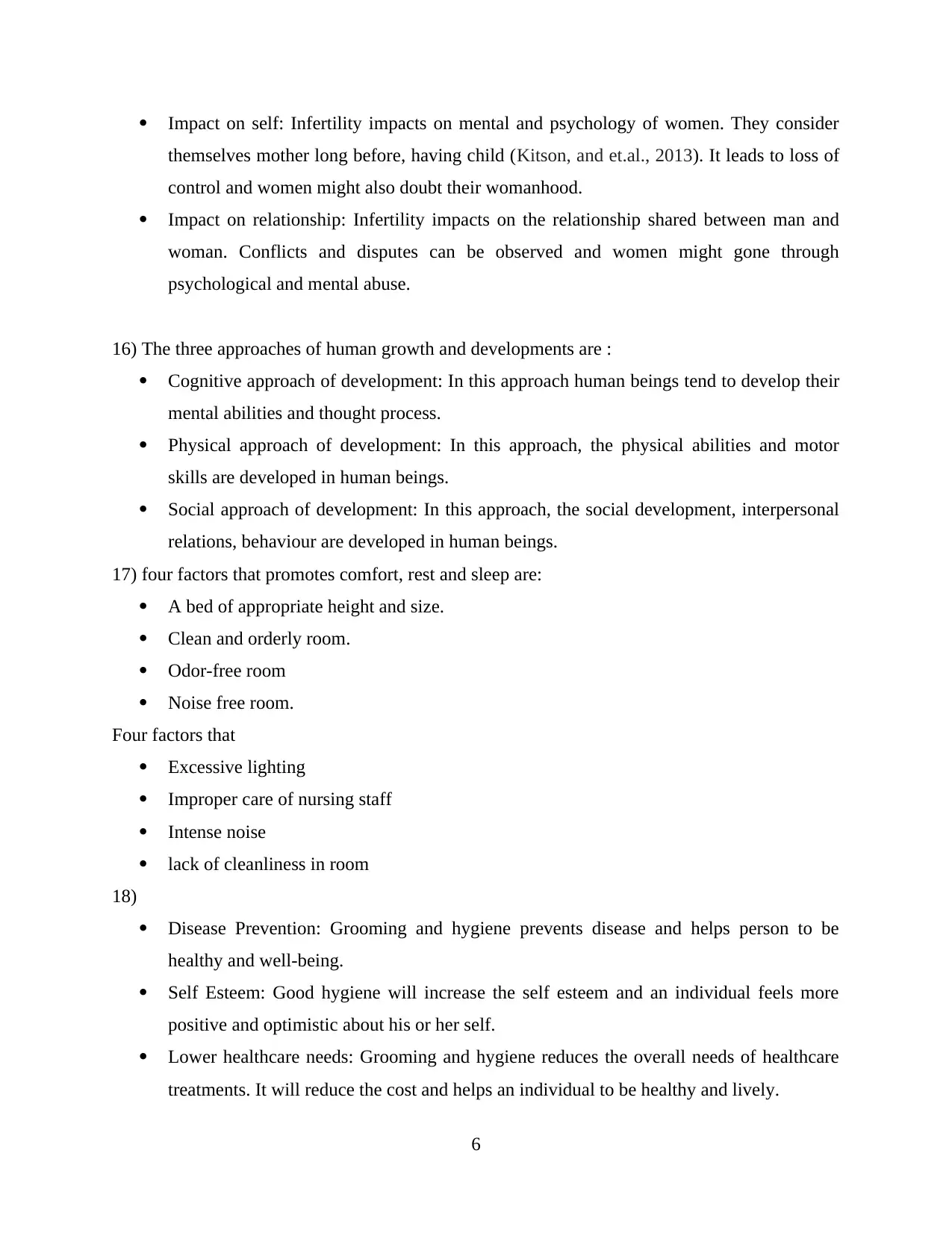
Impact on self: Infertility impacts on mental and psychology of women. They consider
themselves mother long before, having child (Kitson, and et.al., 2013). It leads to loss of
control and women might also doubt their womanhood.
Impact on relationship: Infertility impacts on the relationship shared between man and
woman. Conflicts and disputes can be observed and women might gone through
psychological and mental abuse.
16) The three approaches of human growth and developments are :
Cognitive approach of development: In this approach human beings tend to develop their
mental abilities and thought process.
Physical approach of development: In this approach, the physical abilities and motor
skills are developed in human beings.
Social approach of development: In this approach, the social development, interpersonal
relations, behaviour are developed in human beings.
17) four factors that promotes comfort, rest and sleep are:
A bed of appropriate height and size.
Clean and orderly room.
Odor-free room
Noise free room.
Four factors that
Excessive lighting
Improper care of nursing staff
Intense noise
lack of cleanliness in room
18)
Disease Prevention: Grooming and hygiene prevents disease and helps person to be
healthy and well-being.
Self Esteem: Good hygiene will increase the self esteem and an individual feels more
positive and optimistic about his or her self.
Lower healthcare needs: Grooming and hygiene reduces the overall needs of healthcare
treatments. It will reduce the cost and helps an individual to be healthy and lively.
6
themselves mother long before, having child (Kitson, and et.al., 2013). It leads to loss of
control and women might also doubt their womanhood.
Impact on relationship: Infertility impacts on the relationship shared between man and
woman. Conflicts and disputes can be observed and women might gone through
psychological and mental abuse.
16) The three approaches of human growth and developments are :
Cognitive approach of development: In this approach human beings tend to develop their
mental abilities and thought process.
Physical approach of development: In this approach, the physical abilities and motor
skills are developed in human beings.
Social approach of development: In this approach, the social development, interpersonal
relations, behaviour are developed in human beings.
17) four factors that promotes comfort, rest and sleep are:
A bed of appropriate height and size.
Clean and orderly room.
Odor-free room
Noise free room.
Four factors that
Excessive lighting
Improper care of nursing staff
Intense noise
lack of cleanliness in room
18)
Disease Prevention: Grooming and hygiene prevents disease and helps person to be
healthy and well-being.
Self Esteem: Good hygiene will increase the self esteem and an individual feels more
positive and optimistic about his or her self.
Lower healthcare needs: Grooming and hygiene reduces the overall needs of healthcare
treatments. It will reduce the cost and helps an individual to be healthy and lively.
6
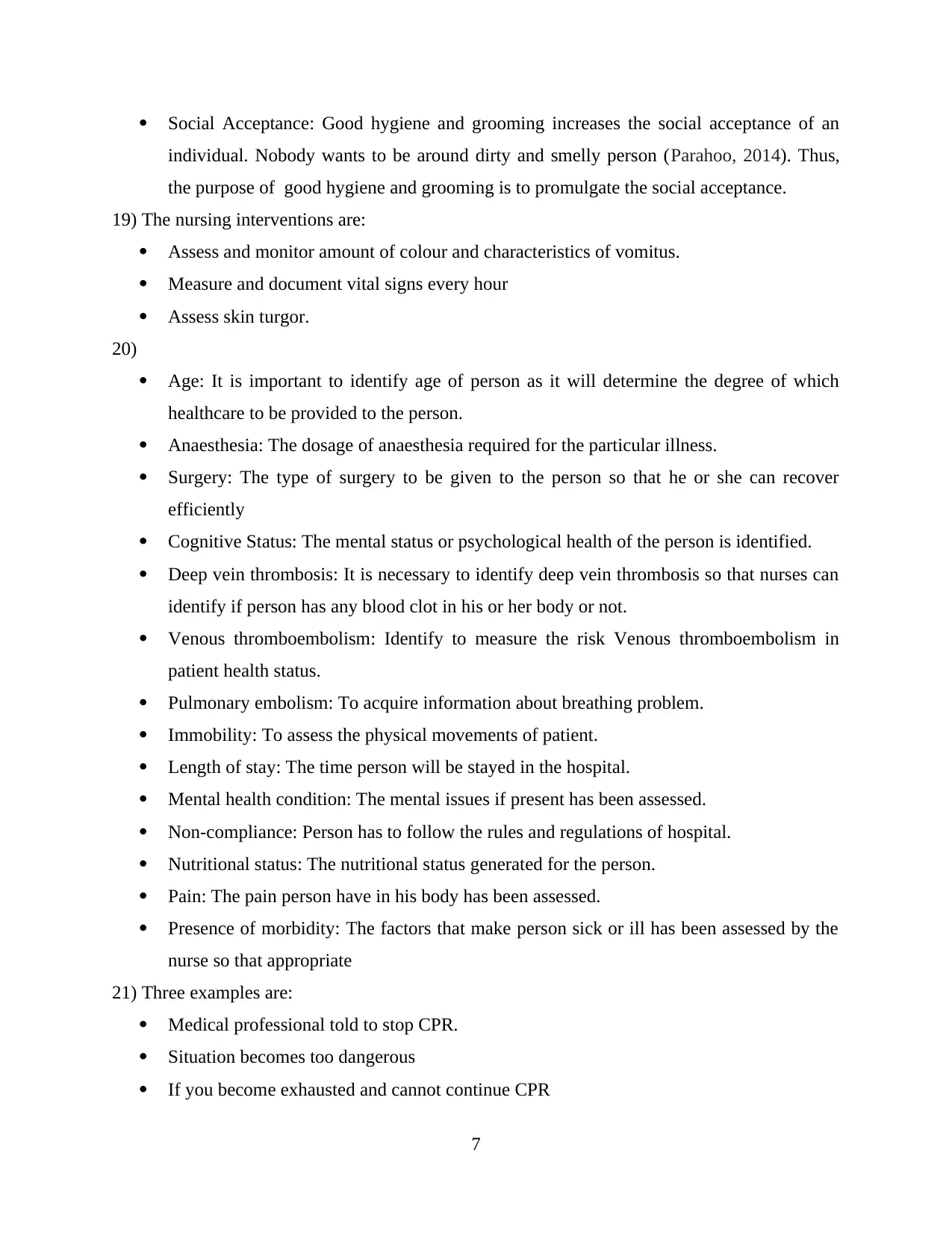
Social Acceptance: Good hygiene and grooming increases the social acceptance of an
individual. Nobody wants to be around dirty and smelly person (Parahoo, 2014). Thus,
the purpose of good hygiene and grooming is to promulgate the social acceptance.
19) The nursing interventions are:
Assess and monitor amount of colour and characteristics of vomitus.
Measure and document vital signs every hour
Assess skin turgor.
20)
Age: It is important to identify age of person as it will determine the degree of which
healthcare to be provided to the person.
Anaesthesia: The dosage of anaesthesia required for the particular illness.
Surgery: The type of surgery to be given to the person so that he or she can recover
efficiently
Cognitive Status: The mental status or psychological health of the person is identified.
Deep vein thrombosis: It is necessary to identify deep vein thrombosis so that nurses can
identify if person has any blood clot in his or her body or not.
Venous thromboembolism: Identify to measure the risk Venous thromboembolism in
patient health status.
Pulmonary embolism: To acquire information about breathing problem.
Immobility: To assess the physical movements of patient.
Length of stay: The time person will be stayed in the hospital.
Mental health condition: The mental issues if present has been assessed.
Non-compliance: Person has to follow the rules and regulations of hospital.
Nutritional status: The nutritional status generated for the person.
Pain: The pain person have in his body has been assessed.
Presence of morbidity: The factors that make person sick or ill has been assessed by the
nurse so that appropriate
21) Three examples are:
Medical professional told to stop CPR.
Situation becomes too dangerous
If you become exhausted and cannot continue CPR
7
individual. Nobody wants to be around dirty and smelly person (Parahoo, 2014). Thus,
the purpose of good hygiene and grooming is to promulgate the social acceptance.
19) The nursing interventions are:
Assess and monitor amount of colour and characteristics of vomitus.
Measure and document vital signs every hour
Assess skin turgor.
20)
Age: It is important to identify age of person as it will determine the degree of which
healthcare to be provided to the person.
Anaesthesia: The dosage of anaesthesia required for the particular illness.
Surgery: The type of surgery to be given to the person so that he or she can recover
efficiently
Cognitive Status: The mental status or psychological health of the person is identified.
Deep vein thrombosis: It is necessary to identify deep vein thrombosis so that nurses can
identify if person has any blood clot in his or her body or not.
Venous thromboembolism: Identify to measure the risk Venous thromboembolism in
patient health status.
Pulmonary embolism: To acquire information about breathing problem.
Immobility: To assess the physical movements of patient.
Length of stay: The time person will be stayed in the hospital.
Mental health condition: The mental issues if present has been assessed.
Non-compliance: Person has to follow the rules and regulations of hospital.
Nutritional status: The nutritional status generated for the person.
Pain: The pain person have in his body has been assessed.
Presence of morbidity: The factors that make person sick or ill has been assessed by the
nurse so that appropriate
21) Three examples are:
Medical professional told to stop CPR.
Situation becomes too dangerous
If you become exhausted and cannot continue CPR
7
⊘ This is a preview!⊘
Do you want full access?
Subscribe today to unlock all pages.

Trusted by 1+ million students worldwide
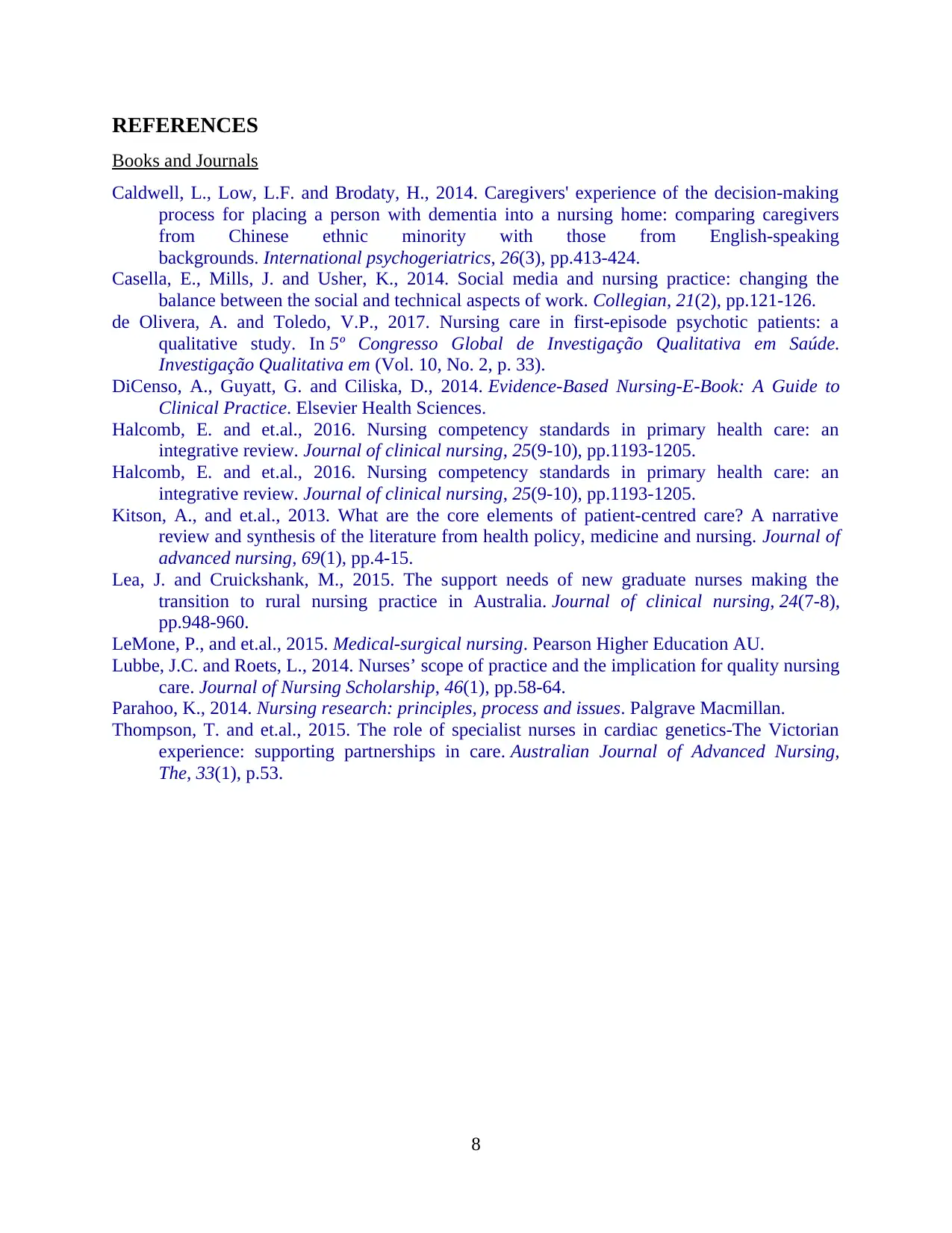
REFERENCES
Books and Journals
Caldwell, L., Low, L.F. and Brodaty, H., 2014. Caregivers' experience of the decision-making
process for placing a person with dementia into a nursing home: comparing caregivers
from Chinese ethnic minority with those from English-speaking
backgrounds. International psychogeriatrics, 26(3), pp.413-424.
Casella, E., Mills, J. and Usher, K., 2014. Social media and nursing practice: changing the
balance between the social and technical aspects of work. Collegian, 21(2), pp.121-126.
de Olivera, A. and Toledo, V.P., 2017. Nursing care in first-episode psychotic patients: a
qualitative study. In 5º Congresso Global de Investigação Qualitativa em Saúde.
Investigação Qualitativa em (Vol. 10, No. 2, p. 33).
DiCenso, A., Guyatt, G. and Ciliska, D., 2014. Evidence-Based Nursing-E-Book: A Guide to
Clinical Practice. Elsevier Health Sciences.
Halcomb, E. and et.al., 2016. Nursing competency standards in primary health care: an
integrative review. Journal of clinical nursing, 25(9-10), pp.1193-1205.
Halcomb, E. and et.al., 2016. Nursing competency standards in primary health care: an
integrative review. Journal of clinical nursing, 25(9-10), pp.1193-1205.
Kitson, A., and et.al., 2013. What are the core elements of patient‐centred care? A narrative
review and synthesis of the literature from health policy, medicine and nursing. Journal of
advanced nursing, 69(1), pp.4-15.
Lea, J. and Cruickshank, M., 2015. The support needs of new graduate nurses making the
transition to rural nursing practice in Australia. Journal of clinical nursing, 24(7-8),
pp.948-960.
LeMone, P., and et.al., 2015. Medical-surgical nursing. Pearson Higher Education AU.
Lubbe, J.C. and Roets, L., 2014. Nurses’ scope of practice and the implication for quality nursing
care. Journal of Nursing Scholarship, 46(1), pp.58-64.
Parahoo, K., 2014. Nursing research: principles, process and issues. Palgrave Macmillan.
Thompson, T. and et.al., 2015. The role of specialist nurses in cardiac genetics-The Victorian
experience: supporting partnerships in care. Australian Journal of Advanced Nursing,
The, 33(1), p.53.
8
Books and Journals
Caldwell, L., Low, L.F. and Brodaty, H., 2014. Caregivers' experience of the decision-making
process for placing a person with dementia into a nursing home: comparing caregivers
from Chinese ethnic minority with those from English-speaking
backgrounds. International psychogeriatrics, 26(3), pp.413-424.
Casella, E., Mills, J. and Usher, K., 2014. Social media and nursing practice: changing the
balance between the social and technical aspects of work. Collegian, 21(2), pp.121-126.
de Olivera, A. and Toledo, V.P., 2017. Nursing care in first-episode psychotic patients: a
qualitative study. In 5º Congresso Global de Investigação Qualitativa em Saúde.
Investigação Qualitativa em (Vol. 10, No. 2, p. 33).
DiCenso, A., Guyatt, G. and Ciliska, D., 2014. Evidence-Based Nursing-E-Book: A Guide to
Clinical Practice. Elsevier Health Sciences.
Halcomb, E. and et.al., 2016. Nursing competency standards in primary health care: an
integrative review. Journal of clinical nursing, 25(9-10), pp.1193-1205.
Halcomb, E. and et.al., 2016. Nursing competency standards in primary health care: an
integrative review. Journal of clinical nursing, 25(9-10), pp.1193-1205.
Kitson, A., and et.al., 2013. What are the core elements of patient‐centred care? A narrative
review and synthesis of the literature from health policy, medicine and nursing. Journal of
advanced nursing, 69(1), pp.4-15.
Lea, J. and Cruickshank, M., 2015. The support needs of new graduate nurses making the
transition to rural nursing practice in Australia. Journal of clinical nursing, 24(7-8),
pp.948-960.
LeMone, P., and et.al., 2015. Medical-surgical nursing. Pearson Higher Education AU.
Lubbe, J.C. and Roets, L., 2014. Nurses’ scope of practice and the implication for quality nursing
care. Journal of Nursing Scholarship, 46(1), pp.58-64.
Parahoo, K., 2014. Nursing research: principles, process and issues. Palgrave Macmillan.
Thompson, T. and et.al., 2015. The role of specialist nurses in cardiac genetics-The Victorian
experience: supporting partnerships in care. Australian Journal of Advanced Nursing,
The, 33(1), p.53.
8
1 out of 10
Related Documents
Your All-in-One AI-Powered Toolkit for Academic Success.
+13062052269
info@desklib.com
Available 24*7 on WhatsApp / Email
![[object Object]](/_next/static/media/star-bottom.7253800d.svg)
Unlock your academic potential
Copyright © 2020–2025 A2Z Services. All Rights Reserved. Developed and managed by ZUCOL.





